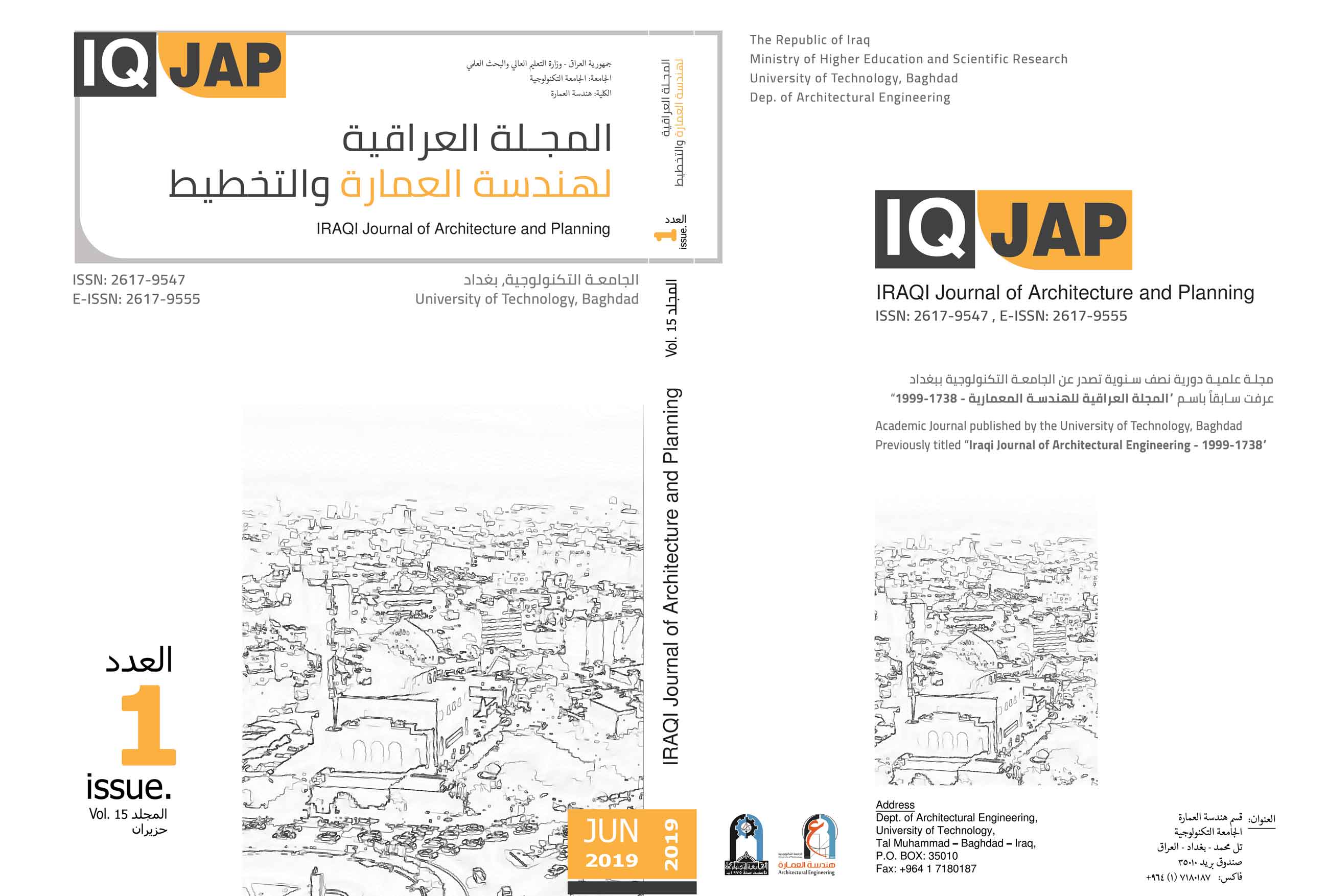Constraints of Green Buildings in Iraqi Cities
Abstract
The construction and buildings sector are one of the most energy-consuming sectors, accounting for one-third of the world's total energy consumption and one-third of the world's CO2 emissions, this leads to environmental, health and psychological damages for humans and society, with an increase in other urban problems in city. This is result of reliance on fossil fuels, construction materials and excessive consumption of natural resources that cause an increase in greenhouse gas emissions.
Concept of green buildings has emerged with sustainable trends in fields of architecture and urban planning. It is considered an integrated architecture with environment and nature. It reduces pollution rate to 1/6 of world's CO2 emissions. It provides a safe, comfortable and healthy environment for human and reduces the consumption and preservation of natural resources, for future generations by recycling waste, wastewater, roofs and green facades, and use of suitable building materials with the environment, as well as integrated design with buildings and urban context in terms of formation and direction of buildings and use of sustainable building materials and use of renewable energy and others.
The climate in Iraq, especially in summer, is characterized by high temperatures. It is more than 50 °c, with winter temperatures dropping and uneven significantly between summer and winter, so we need buildings that consider the requirements of human thermal comfort, reduce energy consumption and natural resources, and provide a healthy and psychological environment, to reduces emissions harmful to environment.
There are many obstacles to establishment of green buildings in Iraqi cities, most important of which are laws and legislation that require its legislation to suit technological advances in architecture, as well as technical, and social constraints and others.
Downloads
References
Bachman, Leonard R. (2003) “Integrated Buildings: The System Basis of Architecture†John Wiley & Sons, New Jersey, USA.
Bang, Cathryn & Partners (2010) “Integration of Nanotechnology Materials for Green Building†Nanomaterials application for green building, Healthcare Architecture Planning, Interior, New York, USA.
Barnett, Dianna Lopez & Browning, William D. (2007) “A Primer on Sustainable Architecture†Rocky Mountain Institute (RMI), Green Development Services, USA.
Barrows, John & Iannucci, Lisa (2009) “The Complete IDIOT'S Guide to Green Building and Remodeling†ALPHA Book, A member of Penguin Group (USA) Inc.
Bauer, Michael & et al., (2010) “Green Building – Guidebook for Sustainable Architecture†Springer – Verlag Berlin Heidelberg, Stuttgart, Germany.
Edwards, Brain (2005) “Green Building Pay†E & FN Spon, an Imprint of Routledge, London, UK.
Energy Star (2006) “Energy Star ® and other Climate Protection Partnership†Annual report, EPA United State Environmental Protection Agency, USA.
Garrison, Noah & Horowitz, Cara (2012) “Looking Up: How Green Roof and Cool Roof Can Reduce Energy Use, Address Climate Change, and Protect Water Resources in Southern California†Natural Resource Defense Council (NRDC) report, Emmet Center on Climate Change and Environment, UCLA School of Law, USA.
Haglund, Bruce & Rathmann, Kurt (1995) “Thermal Mass in Passive Solar and Energy Conserving Building†Vital Signs Curriculum Material Project, USA/
Hui, Sam C. M. (2002) “Sustainable Architecture†Sustainable Architecture and Building Design (SABD), USA.
Lang, Jones & Meghraj, LaSalle (2008) “India Green Building Anthology†Jones Lang LaSalle Meghraj Property Consultants Pvt. Ltd., India.
Strong, David & Burrows, Victoria (2017) “A Whole-System Approach to High-Performance Green Buildings†Artech House, Boston, London.
Woolley, Tom & Kimmins, Sam & Harrison, Paul & Harrison, Rob (2005) “Green Building Handbook†vol. 1, Spon Press and Taylor & Francis Group. Boston, London.
Words & Images (2008) “Green Building: Understanding, Bidding and Building Green†Foundation of the Wall and Ceiling Industry (FWCI), USA.
Yudelson, Jerry (2007) “Green Building A to Z: Understanding the Language of Green Building†New Society Publishers, Canada.
Kamwa, Ghada Mohamed Ismail (2015) "Green Architecture Systems in Sustainable Environmental Design" PhD thesis, Department of Architecture, Faculty of Engineering, University of Baghdad, Iraq.
Younis, Ghada Mohammed (2011) "The Human Dimensions of Green Architecture: The Privacy of Japanese Architecture (Nikken Sekkei)", Rafidain Magazine, Faculty of Engineering, Mosul University, Issue 4, Volume 19,
Copyright (c) 2019 Nabil Taha Ismaeel and AbdulHussain Ali Hussain

This work is licensed under a Creative Commons Attribution-ShareAlike 4.0 International License.
You are free to use the work, but you have to attribute (refer to) the work in the manner specified by the author or licensor (but not in any way that suggests that they endorse you or your use of the work).
IRAQI J. ARCHIT & PLANN grants you the right to publish the metadata of the journal, it's issues and articles under the terms of the Creative Commons Attribution-ShareAlike 4.0 International License.
Author(s) hold the copyright of their aricles without restrictions. However, IRAQI J. ARCHIT & PLANN holds publishing rights for articles and their revisions once the article is published.
Authors can archive pre-prints (ie pre-refereeing) and post-prints (i.e. final draft post-refereeing) versions of the work they submitted to IRAQI J. ARCHIT & PLANN using non-for-profit open-access servers whether on author's personal website and/or institutional repositories including the university or research center where the author work.. For post-prints, only the IRAQI J. ARCHIT & PLANN’s as-published PDF version is permitted and the published source (IRAQI J. ARCHIT & PLANN’s website) must be clearly acknowledged within the archiving webpage.






